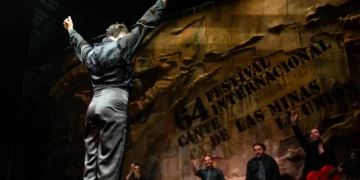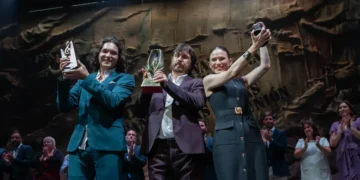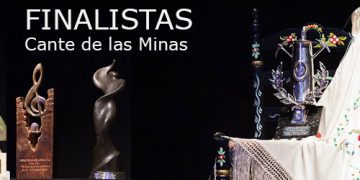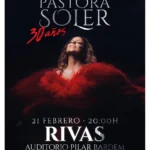Text & photos: Rafael Manjavacas
After ten days, the Festival came to an end with the contest finals of the Cante de las Minas that has added the names of Antonia Contreras, («Lámpara Minera»), Belén («Desplante») for dance and Alfonso Aroca («Filón») for flamenco instrumentalist, leaving the guitar prize, the «Bordón», unawarded.
Echoes of the minera interpreted by Málaga singer Antonia Contreras which earned her the coveted «Lámpara Minera» at the Cathedral of Cante in La Unión can still be heard. This represents a year of glory for her, and a turning point in her artistic career. The singer competed for the trophy with Extremaduran singer Esther Merino, who finally won the prize for tarantos, and Amparo Reyes «Le Repompilla» who received the prize for soleares; last year this singer won for tangos and seguiriyas. Not eligible for the Lámpara Minera, Isabel Guerrero won the prize for cartagenera, and Cádiz singer José Anillo won for alegrías, so everyone went home happy and Evaristo Cuevas won for Seguiriyas.
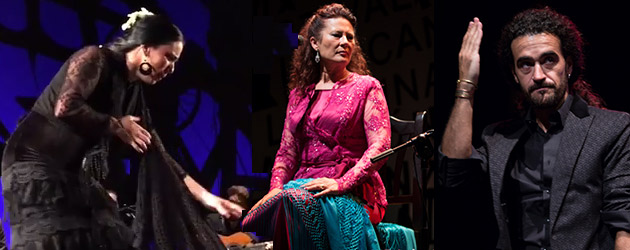
In the category of Flamenco Instrumentalist, Alfonso Aroca from Jaén finally won the «Filón» on his third try, competing with flautist Sergio de Lope, who won second prize. They had a fine rapport, two buddies from the same band.
And in dance, the exultant winner was Belén López, who prepared her choreography of tarantos with utmost care, with brilliant results. Belén López has a long artistic career, having danced since the age of 9, and winning the Mario Maya prize at Córdoba's National Contest in the year 2004 when she was 18. Since then, she has performed on Spain's most important stages, and with her company she has appeared at important festivals such as the Festival de Jerez, Suma Flamenca and the Festival de Nimes. Without a doubt this prize will give new impetus to her career, and the girl from Tarragona, who lives in Madrid, will take full advantage with new projects.
Anabel Veloso, the dancer from Almería, danced tarantos very well, with a very different style, elegant and subtle, although lacking the intensity of her rival. Anabel made it to the Festival thanks to the insistence of her friends in Almería, but with her mind focused on the two shows she has prepared for the Bienal de Sevilla which begins in September.
Eveyone was happy since all expectations among flamenco followers were fulfilled. The panel of judges presided by dancer Blanca del Rey, excellent keynote speaker on the Festival's opening day, included Pedro Ojesto –flamenco and jazz pianist-, journalists Manuel Curao –Canal Sur- and Antonio Parra –El País- and Francisco Paredes, flamencologist from La Unión. On the final day Seville singer Segundo Falcón joined the panel. It's a tradition that the contest's judges give cause for criticism, and this year the discrepancies were more due to the artists selected for the finals than for the actual results, the most heated commentaries regarding the decision not to award the guitar prize known as the «Bordon Minero» for the fourth time in the last five years.
La Unión receives flamenco fans from all parts of Spain, from Andalucía, Extremadura, Madrid, Cataluña, as well as Galicia, Asturias…we don't have the exact statistics, but at DeFlameno's stall in the market, we chatted with nearly everyone, some of whom return year after year, and new people as well. We said hi to fans from France, Germany, Great Britain, Italy, Mexico, the United States… The world's most mediatic flamenco festival was sold out for nearly all the shows, and of course, the day of the finals. Video Agustín Carbonell «Bola».
This year's novelty at the Festival was the series «Flamenco in the Street», but with nearly unknown artists, being most noteworthy the participation of Japanese dancer Ariko Yara, and the performance of singer Marisa Valle and her group who brought «mining music» from Asturias. There was also flamenco at the Agrupa Vicenta mine with Granada singer Juan Pinilla, the awarding of an honorific “Lámpara Minera” to local singer «Niño Alfonso», the usual flamenco dance courses and the 3rd Seminario Internacional de Flamenco para Instrumentos Melódicos, directed by musician Óscar de Manuel. Talks were offered devoted to Miguel Hernández and Juanito Valderrama, and Francisco Sánchez Duendes had a photography exhibit.
Other noteworthy prizes in this edition were from Germany, with the award «Catedral del Cante», the “Carburo Minero” for José Mercé, the distinctions “Pencho Cros al Periodismo” for Teo Sánchez –Duendeando Radio3, RNE -, “Pencho Cros a la difusión musical” for the Festival de Jerez and the “Castillete de Oro” for the Instituto Andaluz de Flamenco.
Descubre más desde Revista DeFlamenco.com
Suscríbete y recibe las últimas entradas en tu correo electrónico.




